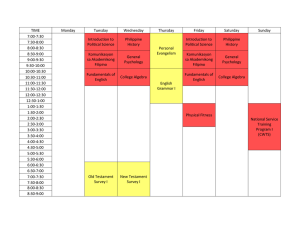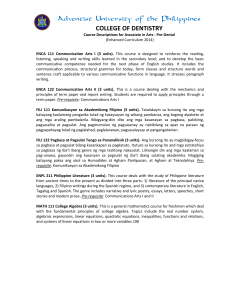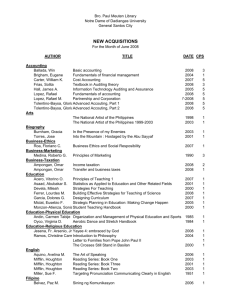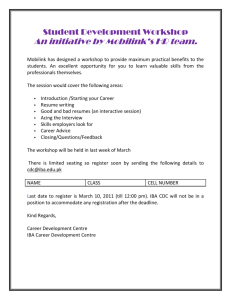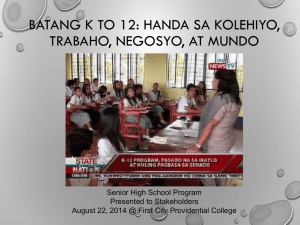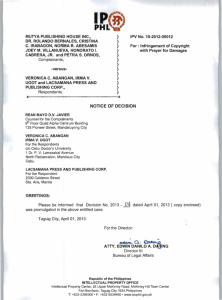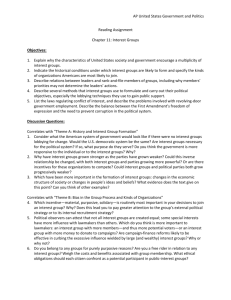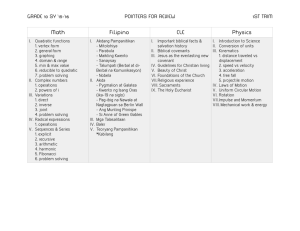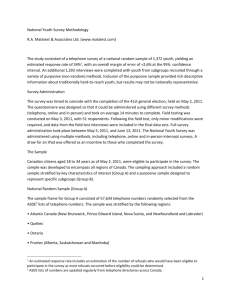CDCE NU Cruz
advertisement
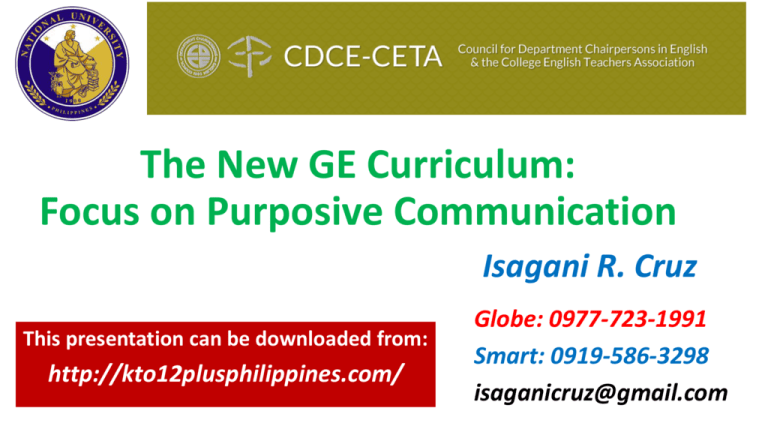
The New GE Curriculum: Focus on Purposive Communication Isagani R. Cruz This presentation can be downloaded from: http://kto12plusphilippines.com/ Globe: 0977-723-1991 Smart: 0919-586-3298 isaganicruz@gmail.com Why change GE (external) SOURCE: CHED Technical Panel on General Education No longer multiple-choice world, need for “big-picture thinking”* Explosion of knowledge New globalized, technology-driven order More complex, widespread problems *Carol Geary Schneider, “In Defense of a Liberal Education,” 10 Aug 2009. Why change GE (internal) More holistic, less disciplinal GE Remedial character of GE College readiness standards New K-12 curriculum SOURCE: CHED Technical Panel on General Education College readiness standards • The nature and elements (addresser, addressee, code, channel, context) of oral communication • Different types of speeches and oral texts • The main varieties of English • Modern technology and communication (multimodality, hypertexts, e-mail, netiquette) College readiness standards • The development of effective reading strategies (steps in the reading process, types of reading discourse markers for comparison and contrast, lexical collocations, verb-noun restrictions, semantic restrictions) • Critical reading (context clues, inference, note taking, interpret) • Rhetorical patterns College readiness standards • Grammatical features (tense consistency/harmony, active and passive voice, gerunds, relative clauses, tense aspect system, coordination and subordination, prepositional phrases, adverbs and adverbials, imperatives, modal auxiliaries, attributive vs. predicate position, relative clause, embedded sentence, degreecomparatives and equatives, demonstrative pronouns, co-occurrence restrictions, the article system, negation) College readiness standards • Organization, coherence and cohesion (discourse markers for citing examples, sequence markers) • Produce clear and concise career-oriented/technical writings such as memos, business letters, résumés, technical reports, and information analyses • Write a research paper of at least 1,000 words, with proper documentation of all sources Holistically developed Filipino with 21st century skills 12 11 10 9 8 7 6 LANGUAGES MATH AP EP SCIENCE MAPEH EPP TLE 5 4 3 2 1 K Curriculum Exits DEPARTMENT OF EDUCATION SOURCE: DepEd Komunikasyon at Pananaliksik sa Wika at Kulturang Pilipino • Mga Konseptong Pangwika • Gamit ng Wika sa Lipunan • Kasaysayan ng Wikang Pambansa Pagbasa at Pagsusuri ng Iba’t Ibang Teksto Tungo sa Pananaliksik • Mga Uri ng Teksto • Pagbasa at Pagsusuri ng Iba’t Ibang Teksto Filipino sa Piling Larangan: Akademik • Kahulugan, kalikasan, at katangian ng pagsulat ng sulating akademik • Pagsulat ng akademikong sulatin Oral Communication in Context • Nature and Elements of Communication • Functions of Communication • Communicative Competence • Strategies in Various Speech Situations • Types of Speeches Reading and Writing • Reading and Thinking Strategies across Text Types • Text and Context Connections / Critical Reading • Purposeful Writing in the Disciplines and for Professions English for Academic and Professional Purposes • Reading Academic Texts • Writing the Reaction Paper / Review / Critique • Writing Concept Paper • Writing the Position Paper • Writing the Report Survey / Field Report / Laboratory / Scientific Technical Report Pag-unawa sa Sarili Etika Pagpapahalaga sa Sining Mga Babasahin hinggil sa Kasaysayan ng Filipinas Ang Kasalukuyang Daigdig Malayuning Komunikasyon Matematika sa Makabagong Daigdig Agham, Teknolohiya, at Lipunan Core (24 u.) Mandated Elective (9 u.) GE Rizal, PE, NSTP, Taxation, Agrarian Reform, Philippine Constitution, Family Planning, Population Education •Understanding the Self Readings in Phil History The Contemporary World Mathematics in the Modern World Purposive Communication Ethics Art Appreciation Core (24 u.) ST & Society Mandated Elective (9 u.) GE Rizal, PE, NSTP, Taxation, Agrarian Reform, Philippine Constitution, Family Planning, Population Education Malayuning Komunikasyon / Purposive Communication Pagsulat, pagsasalita, at paglalahad para sa iba’t ibang madla at iba’t ibang layunin / Writing, speaking, and presenting to different audiences and for various purposes Purposive Communication / Malayuning Komunikasyon The five skills of communication (listening, speaking, reading, writing, viewing) are studied and simulated in advanced academic settings, such as conversing intelligently on a subject of import, reporting on group work and/or assignments, writing and delivering a formal speech, writing minutes of meetings and similar documents, preparing a research or technical paper, and making an audio-visual or web-based presentation. Purposive Communication / Malayuning Komunikasyon In the process, the criteria for effective communication are discussed and used as the basis of peer evaluation of communication exercises in the class as well as for judging communication techniques used by public officials, educators, industry leaders, churches, and private individuals. The purpose of these combined activities is to enable students to practice strategies of communication with a clear purpose and audience in mind, guided by the criteria of effective communication and the appropriate language. Purposive Communication / Malayuning Komunikasyon At the end of the course, students should be able to listen, comprehend, critique, and respond to live or recorded conversations, speak in public with confidence, explain extended texts in their own words using examples and other aids to bolster their explanation, write texts ranging from a simple report to a fulllength technical or research paper (scientific, social science, or literary, depending on the student’s major), and prepare an audio-visual or web-based presentation on an assigned topic. Let me zero in, however, on just one phrase: “judging communication techniques used by public officials.” The most important public official, needless to say, is the president of the republic. Benigno Simeon Cojuangco Aquino III, in his public oral communication, has used almost exclusively the Filipino language. How a teacher in an English department can analyze the vocabulary he uses, the register, the interaction between the film clips and slides that he uses and the words he speaks, is clearly problematic. There are, of course, English teachers that understand the semantic import of using nakakagulat instead of nakagugulat, but they are not the usual ones we find in our classrooms. On the other hand, it would be difficult to find a teacher of Filipino that can extensively handle the finer points of a technical paper in, say, medicine or engineering or other professional fields. Again, we do have extraordinary individuals that are real bilinguals when it comes to linguistic prowess, but they are extraordinary, not ordinary. The ordinary teacher in the ordinary college classroom can perhaps handle part of Purposive Communication but definitely not all of it. I would even venture to say not any of it. Globe: 0977-723-1991 Smart: 0919-586-3298 isaganicruz@gmail.com
